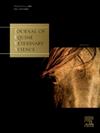Morphometric characteristics of quarter horses in barrel racing events: impacts on performance and competitive success
IF 1.6
3区 农林科学
Q2 VETERINARY SCIENCES
引用次数: 0
Abstract
Aims
This study investigated the influence of morphometric characteristics on performance in Quarter Horses competing in barrel racing.
Methods
A total of 125 horses were assessed using 28 linear and angular body measurements derived from standardized left-side photographs captured via smartphone and analyzed with open-source software.
Results
Measurements were subjected to exploratory factor analysis, extracting six principal components (forequarters, hindquarters, midsection, posterior angles, scapular traits, age and weight), which together explained 83.0 % of the morphological variance. Forequarter morphology, including withers height and limb lengths, accounted for 37.4 % of the variation in race performance. Hierarchical cluster analysis grouped horses by trial times, revealing that animals with faster times exhibited significantly larger ribcage dimensions, longer scapulae, and greater coxofemoral angles. A multivariate regression model incorporating the principal components predicted individual potential trial times with high accuracy (R² = 0.6848; P = 0.0388), and comparisons with actual times confirmed the model’s validity. Age and body weight were also relevant, with younger, well-muscled horses demonstrating superior performance.
Conclusion
Forequarter conformation, scapular inclination, and indicators of respiratory and muscular capacity were strong predictors of barrel racing success in Quarter Horses, and image-based morphometric analysis was a valuable tool for performance prediction and selection in this study.
四分之一马在桶装赛中的形态特征:对表现和竞技成功的影响。
目的:研究形态计量学特征对四分之一马桶装赛成绩的影响。方法:通过智能手机拍摄的标准化左侧照片,对125匹马进行28个线性和角度的身体测量,并使用开源软件进行分析。结果:对测量结果进行探索性因子分析,提取出6个主成分(前躯、后躯、中躯、后角、肩胛骨特征、年龄和体重),共解释了83.0%的形态变异。前肢形态,包括肩高和肢长,占比赛成绩变化的37.4%。分层聚类分析根据试验时间对马进行分组,结果显示,试验时间越快的马,其胸腔尺寸明显越大,肩胛骨长度越长,肩关节角也越大。结合主成分的多元回归模型预测个体潜在试验次数准确率较高(R² = 0.6848;P = 0.0388),与实际试验次数比较证实了模型的有效性。年龄和体重也有关系,年轻、肌肉发达的马表现出更好的表现。结论:前肢构象、肩胛骨倾角、呼吸和肌肉容量等指标是四分之一马竞速成功的有力预测指标,基于图像的形态计量学分析是本研究中预测和选择成绩的有价值的工具。
本文章由计算机程序翻译,如有差异,请以英文原文为准。
求助全文
约1分钟内获得全文
求助全文
来源期刊

Journal of Equine Veterinary Science
农林科学-兽医学
CiteScore
2.70
自引率
7.70%
发文量
249
审稿时长
77 days
期刊介绍:
Journal of Equine Veterinary Science (JEVS) is an international publication designed for the practicing equine veterinarian, equine researcher, and other equine health care specialist. Published monthly, each issue of JEVS includes original research, reviews, case reports, short communications, and clinical techniques from leaders in the equine veterinary field, covering such topics as laminitis, reproduction, infectious disease, parasitology, behavior, podology, internal medicine, surgery and nutrition.
 求助内容:
求助内容: 应助结果提醒方式:
应助结果提醒方式:


